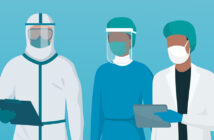BY , RN, BSN, CCM, CRC
I haven’t worked at the bedside in a while. Like many nurses, I began my career in a hospital and was able to work intimately with thousands of different people. Bedside nursing was challenging and fulfilling, but after several years, I needed a change.
Having earned a degree in social work in my life B.C. (before children), I thought a career in case management would combine my skills as a nurse and my skills as a social worker. I joined a new healthcare management start-up and left bedside CRC nursing behind to become a telephonic case manager. Since then, I’ve grown with the company and am now in a place where I have no patient contact. I’m pleased with where I am, I like my job and I feel useful.
And then COVID-19 ushered in a worldwide pandemic.
Like most people, I spent hours on my sofa watching the horror on television. I tracked the skyrocketing numbers in my county, my state and my country. I saw photos of former co-workers on social media with exhausted faces lined with bruises and indentions where their PPE sat for the last 12 hours. I cheered for the front-line workers and called them heroes!
While I was glad to be away from the hospital, I was experiencing what I liken to survivor’s guilt. My friends were in a potentially life-threatening situation every shift, and I was working from home, conducting meetings in my pajama bottoms, quarantined and safe. Yet I had these skills that could be used, should be used, to battle a deadly enemy. I struggled with this for many months. I searched for PRN positions, but no one needed a nurse with rusty skills who could only work a couple of days a month. I signed up to volunteer to be in vaccine clinical trials but was denied when researchers learned I worked from home. I became politically involved in the summer and fall, but it didn’t scratch the itch I had to care for people.
And then…
On December 11, 2020, the FDA issued the first emergency use authorization for a vaccine for the prevention of COVID-19. Hope was on the horizon! I knew many clinicians would be needed to administer the vaccine, and I finally saw an opportunity to help in this awful pandemic.
I reached out to my friend, a public health nurse for the city of Austin, Texas, asking if they were going to take volunteers to man the vaccine clinics. Early on, the city was only interested in hiring licensed healthcare professionals, but they soon discovered hundreds of us were willing and waiting for our chance to help, and we’d do it for free! So instead of hiring hundreds of nurses, they hired three volunteer coordinators. That was money well spent!
Shortly into the new year, I ventured into the back of my closet to find a pair of scrubs. I shook off the dust, put them on and looked in the mirror. I hadn’t seen THAT nurse in quite a while. But there she was, happy, hopeful and ready to jump into action.
My first day in the vaccine clinic was a shot in the arm (pun intended!). Not only was I able to receive my first dose of vaccine, but I was also able to administer a vaccine to about 50 people. Most of the people I saw that day were in Stage 1 A or 1 B who were healthcare workers or the elderly. The buzz in the room was invigorating as people from all walks of life rolled up their sleeves to be inoculated against COVID-19. Despite being masked, I could see the joy, excitement and relief in their eyes and demeanor. Some patients even cried happy tears in anticipation of seeing children and grandchildren in the foreseeable future.
I continued to do this every Saturday for months. The clinics got bigger. We moved from recreation centers to stadiums. The clientele got younger and younger, but the joy, excitement and relief remained on their faces.
Now, the demand for vaccines is waning, and the large stadium clinics are being dismantled. There is still much work to do as efforts are moving to targeted and underserved locations around the city. Vaccine hesitancy is also being addressed through public education campaigns and many one-on-one conversations around the nation.
I don’t know how much longer my injection abilities will be needed since the number of volunteer slots is declining, but I am glad I was given the opportunity to play a small part in the fight. As our economies and communities open up and leave mitigating practices behind, I will continue to educate people in my sphere of influence about the safety and effectiveness of the vaccine. We are rising, but we have not emerged.
One of these days, we will look back and remember this season with a myriad of interpretations and emotions. I hope to look back and have a story or two to tell regarding my time as a COVID-19 vaccine administrator. Perhaps my grandchildren will call me a healthcare hero.





